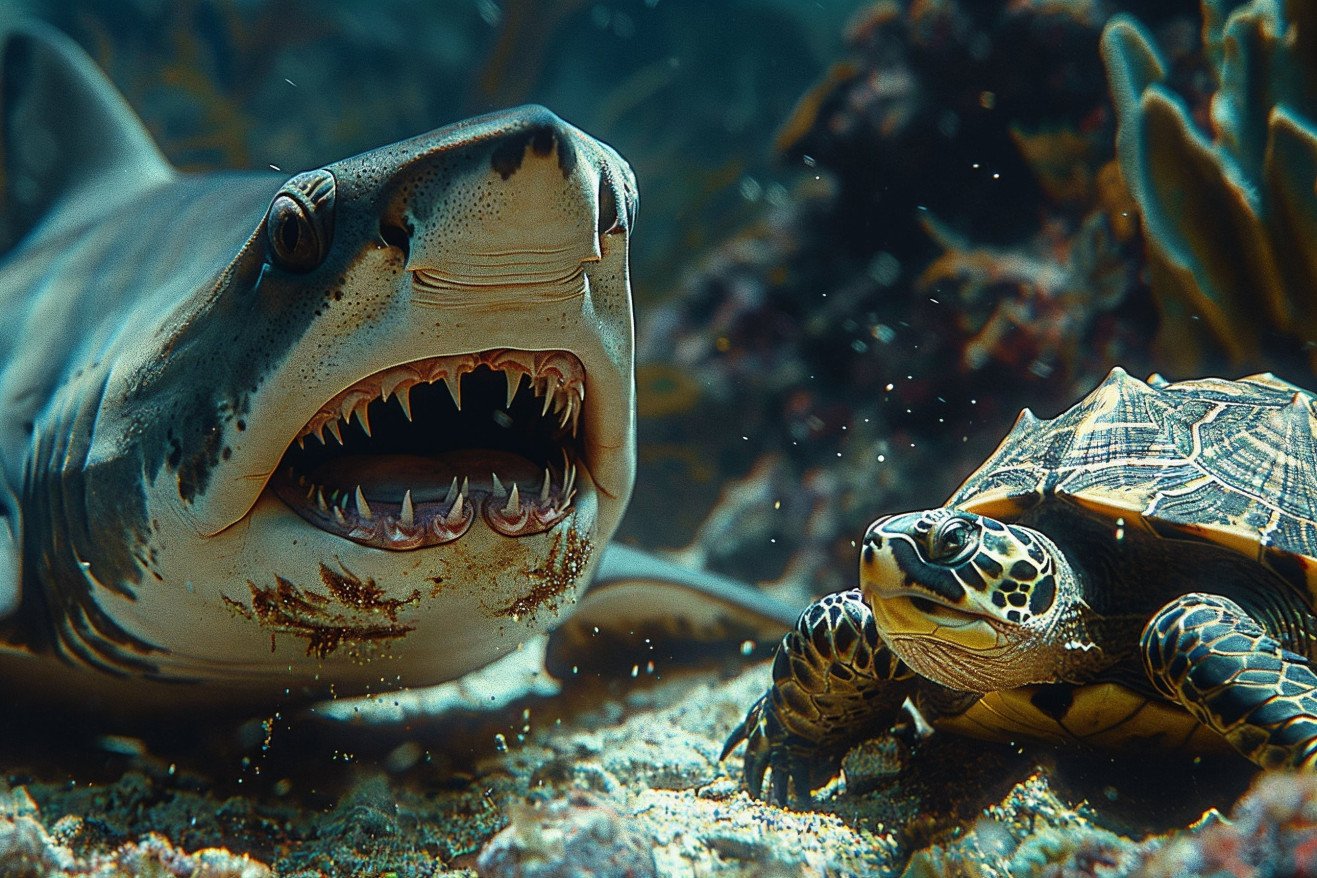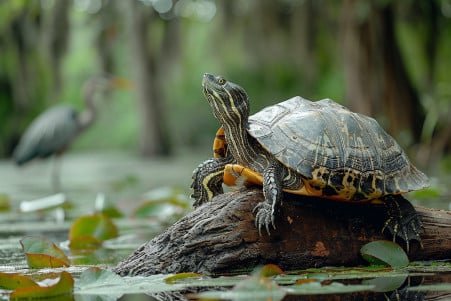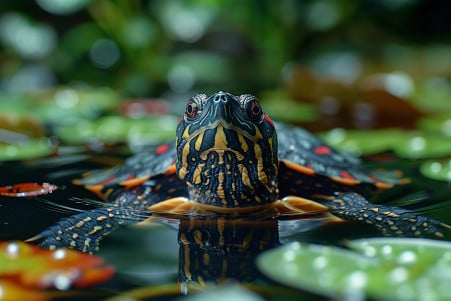Do Fish Eat Turtles? A Look at Predator-Prey Dynamics
29 March 2024 • Updated 29 March 2024

Despite living in the same aquatic ecosystems, fish and turtles don't always get along – in fact, some fish consider turtles to be prey. That's right, some fish eat turtles, and that's especially true for young turtles and smaller turtles that haven't yet developed their shells. Snapping turtles, largemouth bass, and even some catfish are all examples of large predatory fish that are known to prey on turtles.
This article will explore the predator-prey relationship between fish and turtles by looking at both field observations and research studies that have investigated the hunting habits and diets of different fish species in a variety of ecosystems where turtles are found. This work has also helped to uncover the evolutionary arms race that has taken place between fish and turtles, with each developing defenses and hunting strategies to outcompete the other in aquatic environments.
By the end of this article, you'll have a good understanding of the fish that are most likely to eat turtles and the ways that turtles have evolved to avoid becoming fish food.
Do fish eat turtles?
Predatory Fish Species and Their Hunting Behaviors
In freshwater environments, several fish species, including largemouth bass, sunfish, and catfish, are known to prey on turtles, especially young or small turtles. For example, in Louisiana, largemouth bass and sunfish have been shown to trail softshell turtles, feeding on invertebrates that the turtles inadvertently uncover as they disturb the sediment while foraging. This "nuclear-follower foraging association" allows the fish to take advantage of the turtles' hunting behavior.
In the ocean, large predatory sharks are the most significant threat to sea turtles of all ages. Tiger sharks, in particular, have evolved as one of the ocean's most aggressive predators, using their ability to detect electrical fields to home in on their prey. Their powerful jaws and serrated teeth enable them to bite through even the hardest turtle shells. In fact, tiger sharks may have evolved specifically to prey on sea turtles, and they have been observed eating large juvenile and adult turtles.
These fish use a variety of strategies to hunt turtles, including waiting for turtles to uncover their prey while foraging and using their ability to detect electrical fields to locate their prey. In addition, some fish have evolved digestive systems that enable them to more efficiently break down the shells and bones of their turtle prey. The presence and abundance of these predators can have a significant impact on the distribution, behavior, and survival of turtles in the same aquatic environments, and this is just one example of the many factors that contribute to the complex dynamics.
Defensive Adaptations and Behaviors of Turtles
Turtles have developed a hard, bony carapace (upper shell) and plastron (lower shell) as a form of natural defense against predators, according to Sciencing. Many species of turtles can retract their limbs and head into their shells, and some, like the box turtle, can even close their shells to protect themselves.
Other defense mechanisms that turtles use include claws, heightened senses, camouflage, burrowing, and the secretion of smelly substances or defecation. Sea turtles have also developed certain diving behaviors, such as U-shaped dives and slow surface approaches, to avoid being detected by predators like sharks.
Even though their shells offer a lot of protection, turtles can still be vulnerable if they can't right themselves or if a predator is able to overcome their defenses. Understanding these defensive adaptations and behaviors is important for maintaining healthy aquatic ecosystems that include both turtles and their predators.
Environmental and Ecological Factors
The presence and abundance of predatory fish, such as largemouth bass, catfish, and sharks, can have a major impact on the distribution, behavior, and survival of turtles in the aquatic environments they share. Research on predator-prey relationships in aquatic ecosystems has shown that a number of environmental factors, including water temperature, pH, the presence of vegetation, and the availability of refuges, can influence the susceptibility of turtle eggs and hatchlings to predation.
Habitat loss, human disturbance, and overfishing can all lead to disruptions in predator-prey relationships and increased threats to turtles. For example, catastrophic hurricanes in the Caribbean have been shown to temporarily disrupt predator-prey relationships and other ecosystem processes in coastal marine environments. The loss or reduction of important predator species, such as sharks, can lead to imbalances in turtle populations and have cascading effects throughout the ecosystem.
This research highlights the importance of environmental and ecological factors in shaping the interactions between fish and turtles and demonstrates the need to consider these factors in conservation efforts. By understanding these relationships, we can work to ensure the survival of both fish and turtle species and maintain the balance of the ecosystems they inhabit.
Conservation and Ecosystem Management
The relationship between fish and sea turtle populations has important implications for conservation and the management of aquatic ecosystems. The Sea Turtle Conservancy explains that the high levels of predation on turtle nests, which are often made worse by human activities like pollution, can have a major impact on the reproductive success and recovery of these endangered species.
One of the reasons that it’s important to maintain healthy populations of fish that prey on sea turtles, like sharks, is to help control the number of turtles and make sure that they don’t disrupt the rest of the food web. NOAA Fisheries explains that these predator-prey relationships are one of the many factors that are part of the larger, more complicated food web that needs to be considered when taking an ecosystem-based approach to managing these systems.
When it comes to habitat management, it’s important to make sure that the habitats that are being protected and restored are providing the right conditions for turtles to avoid predators. This includes things like the right levels of vegetation and other factors that can provide turtles with places to hide. SEE Turtles explains that it’s important to make sure that the habitats that are being protected and restored are supporting a wide range of species and the interactions between them that are necessary for healthy ecosystems.
In addition, public education can help reduce the human impacts that are disrupting predator-prey relationships. For example, people can be encouraged to make sure that their garbage and pet food is properly secured. By understanding and addressing these issues, we can make sure that we’re protecting the biodiversity of these ecosystems for future generations.
Conclusion: The Importance of Healthy Aquatic Ecosystems
The predator-prey relationship between fish and turtles is a complex and fascinating aspect of aquatic ecosystems. Understanding the hunting behaviors of predatory fish, the defensive adaptations of turtles, and the environmental factors that influence their interactions is crucial for maintaining balanced food webs and healthy populations.
Disruptions to these predator-prey dynamics, whether through habitat degradation, overfishing, or climate change, can have far-reaching consequences for entire ecosystems. Ongoing research and conservation efforts are essential to protect both fish and turtle species, as well as the delicate balance of their shared environments.
By appreciating the intricate relationships between predators and prey, we can better steward and preserve the rich biodiversity of our aquatic ecosystems for generations to come.


